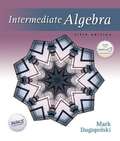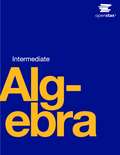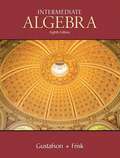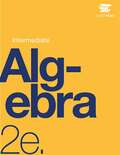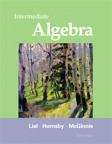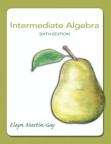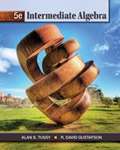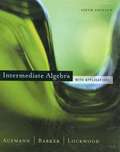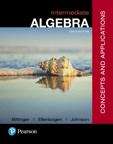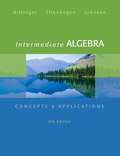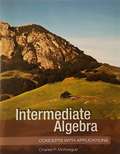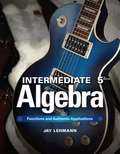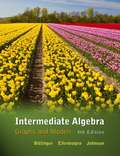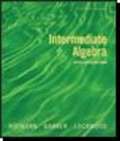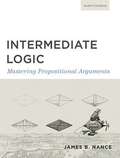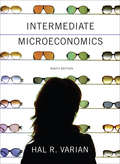- Table View
- List View
Intermediate Algebra
by D. Franklin WrightIntermediate Algebra (sixth edition) provides a solid base for further studies in mathematics. In particular, business and social science majors who will continue their studies in statistics and calculus will be well prepared for success in those courses. With feedback from users, insightful comments from reviewers, and skillful editing and design by the editorial staff at Hawkes Learning Systems, we have confidence that students and instructors alike will find that this text is indeed a superior teaching and learning tool. The text may be used independently or in conjunction with the software package Hawkes Learning Systems: Intermediate Algebra developed by Quant Systems.
Intermediate Algebra
by Margaret L. Lial John Hornsby Terry McginnisStudents who have never studied algebra--as well as those who require further review of basic algebraic concepts before taking additional courses in mathematics, business, science, nursing, or other fields--will benefit from this textbook.
Intermediate Algebra
by John ReddenIt is essential to lay a solid foundation in mathematics if a student is to be competitive in today's global market. The importance of algebra, in particular, cannot be overstated, as it is the basis of all mathematical modeling used in applications found in all disciplines. Traditionally, the study of algebra is separated into a two parts, Elementary and Intermediate Algebra. This textbook by John Redden, Intermediate Algebra, is the second part. Written in a clear and concise manner, it carefully builds on the basics learned in Elementary Algebra and introduces the more advanced topics required for further study in applications found in most disciplines. Used as a standalone textbook, Intermediate Algebra offers plenty of review as well as something new to engage the student in each chapter. Written as a blend of the traditional and graphical approaches to the subject, this textbook introduces functions early and stresses the geometry behind the algebra. While CAS independent, a standard scientific calculator will be required and further research using technology is encouraged.
Intermediate Algebra
by Julie Miller Nancy Hyde Molly ONeillThe 6th Edition of Intermediate Algebra continues the Miller/O'Neill/Hyde author team’s approach in addressing the needs of developmental level students to help them get better results. Content updates include new end-of-section activities, prerequisite review exercises, and new study skills videos.
Intermediate Algebra
by McGraw-HillIntermediate Algebra is designed to provide your students with the algebra background needed for further college-level mathematics courses. The unifying theme of this text is the development of the skills necessary for solving equations and inequalities, followed by the application of those skills to solving applied problems. The primary goal in writing the third edition of Intermediate Algebra has been to retain the features that made the second edition so successful, while incorporating the comments and suggestions of second-edition users. Many new features have been provided that will help instructors reach the goals that they have set for their students. As always, the author endeavors to write texts that students can read, understand, and enjoy, while gaining confidence in their ability to use mathematics.
Intermediate Algebra
by OpenStax"Intermediate Algebra is designed to meet the scope and sequence requirements of a one-semester Intermediate algebra course. The book's organization makes it easy to adapt to a variety of course syllabi. The text expands on the fundamental concepts of algebra while addressing the needs of students with diverse backgrounds and learning styles. Each topic builds upon previously developed material to demonstrate the cohesiveness and structure of mathematics."--Open Textbook Library.
Intermediate Algebra
by OpenStax"Intermediate Algebra is designed to meet the scope and sequence requirements of a one-semester Intermediate algebra course. The book's organization makes it easy to adapt to a variety of course syllabi. The text expands on the fundamental concepts of algebra while addressing the needs of students with diverse backgrounds and learning styles. Each topic builds upon previously developed material to demonstrate the cohesiveness and structure of mathematics."--Open Textbook Library.
Intermediate Algebra (8th Edition)
by R. David Gustafson Peter D. FriskGet the grade you want in algebra with Gustafson and Frisk's INTERMEDIATE ALGEBRA! Written with you in mind, the authors provide clear, no-nonsense explanations that will help you learn difficult concepts with ease. Prepare for exams with numerous resources located online and throughout the text such as online tutoring, Chapter Summaries, Self-Checks, Getting Ready exercises, and Vocabulary and Concept problems. Use this text, and you'll learn solid mathematical skills that will help you both in future mathematical courses and in real life!
Intermediate Algebra (Fourth Edition)
by K. Elayn Martin-GayIntermediate Algebra, Fourth Edition was written to provide a solid foundation in algebra for students who might have had no previous experience in algebra. Specific care has been taken to ensure that students have the most up-to-date and relevant text preparation for their next mathematics course, as well as to help students to succeed in nonmathematical courses that require a grasp of algebraic fundamentals.
Intermediate Algebra (OER): Part 2, Chapters 7–12
by OpenStaxIntermediate Algebra 2e is designed to meet the scope and sequence requirements of a one-semester intermediate algebra course. The book’s organization makes it easy to adapt to a variety of course syllabi. The text expands on the fundamental concepts of algebra while addressing the needs of students with diverse backgrounds and learning styles. The material is presented as a sequence of clear steps, building on concepts presented in pre-algebra and elementary algebra courses. <p><p> The second edition contains detailed updates and accuracy revisions to address comments and suggestions from users. Dozens of faculty experts worked through the text, exercises and problems, graphics, and solutions to identify areas needing improvement. Though the authors made significant changes and enhancements, exercise and problem numbers remain nearly the same in order to ensure a smooth transition for faculty.
Intermediate Algebra 11th Edition
by Margaret L. Lial John Hornsby Terry McginnisIs there anything more beautiful than an "A" in Algebra? Not to the Lial team! Marge Lial, John Hornsby, and Terry McGinnis write their textbooks and accompanying resources with one goal in mind: giving students all the tools they need to achieve success. With this revision, the Lial team has further refined the presentation and exercises throughout the text. They offer several exciting new resources for students that will provide extra help when needed, regardless of the learning environment (classroom, lab, hybrid, online, etc)-new study skills activities in the text, an expanded video program available in MyMathLab.
Intermediate Algebra 8th Edition
by Jeffrey Slater Jamie Blair John Tobey Jr. Jenny CrawfordThe new editions address the latest trends and dynamics related to developmental mathematics course structures, including helping students gain a stronger conceptual understanding, while contextualizing the math. Instructors will find the inclusion of new conceptually oriented Guided Learning Videos with the accompanying Video Workbook with the Math Coach (in MyMathLab), plus a new emphasis on Career Explorations throughout the text and MyMathLab course to help students explore potential career paths. The Tobey series is flexible, and well-suited for a variety of classroom formats, including lecture-based, computer-lab based (modular and/or self-paced), hybrid, and online.
Intermediate Algebra Fifth Edition
by R. David Gustafson Alan S. TussyAlgebra can be like a foreign language, but INTERMEDIATE ALGEBRA, 5E, gives you the tools and practice you need to fully understand the language of algebra and the "why" behind problem solving. Using Strategy and Why explanations in worked examples and a six-step problem solving strategy, INTERMEDIATE ALGEBRA, 5E, will guide you through an integrated learning process that will expand your reasoning abilities as it teaches you how to read, write, and think mathematically. Feel confident about your skills through additional practice in the text and Enhanced WebAssign. With INTERMEDIATE ALGEBRA, 5E, algebra will make sense because it is not just about the x. . . it's also about the WHY.
Intermediate Algebra for College Students (9th Edition)
by Allen R. Angel Dennis C. RundeThrough many successful editions, the Angel team has developed a text that students can read, understand, and enjoy. They've done this by pairing clear explanations (in short sentences!) with detailed examples and thorough exercise sets.
Intermediate Algebra with Applications (6th Edition)
by Richard N. Aufmann Vernon C. Barker Joanne S. LockwoodThe sixth edition of Intermediate Algebra with Applications provides mathematically sound and comprehensive coverage of the topics considered essential in an intermediate algebra course. The text has been designed not only to meet the needs of the traditional college student, but also to serve the needs of returning students whose mathematical proficiency may have declined during years away from formal education.
Intermediate Algebra: Concepts And Applications
by Marvin L. Bittinger Barbara L. Johnson David EllenbogenIntermediate Algebra: Concepts And Applications, 9th Edition (Bittinger Concepts & Applications Ser.)
by Marvin L. Bittinger David J. Ellenbogen Barbara L. JohnsonThe Bittinger Concepts and Applications Program delivers proven pedagogy, guiding students from skills-based math to the concepts-oriented math required for college courses.
Intermediate Algebra: Concepts with Applications
by Charles P. McKeagueThis intermediate text gives practical applications for topics learned in Introductory Algebra. Students can expect a more rigorous approach to algebraic fundamentals. Topics include, but are not limited to: linear equations; exponents and polynomials; rational expressions; quadratic functions; and exponential and logarithmic functions.
Intermediate Algebra: Functions & Authentic Applications
by Jay LehmannIn this course, you will learn not only more about algebra but also how to apply algebra to describe and make predictions about authentic situations.
Intermediate Algebra: Graphs and Models (4th edition)
by Marvin L. Bittinger David J. Ellenbogen Barbara L. JohnsonDrawing examples from business, chemistry, and physics, this textbook walks through graphical and algebraic methods for solving linear equations, inequalities, and polynomials, as well as rational, radical, quadratic, exponential, and logarithmic equations. The second edition moves the conic sections material to an appendix and adds a section on factoring the sums and differences of cubes.
Intermediate Algebra: With Applications
by Richard N. Aufmann Vernon C. Barker Joanne S. LockwoodIntended for developmental math courses in intermediate algebra, this text retains the hallmark features that have made the Aufmann texts market leaders: an interactive approach in an objective-based framework: a clear writing style, and an emphasis on problem-solving strategies. The acclaimed Aufmann Interactive Method, allows students to try a skill as it is introduced with matched-pair examples, offering students immediate feedback, reinforcing the concept, identifying problem areas, and, overall, promoting student success.
Intermediate Logic: Mastering Propositional Arguments (Third Edition)
by James B. NanceThis text is designed as a continuation to Introductory Logic, which I co-authored with Douglas Wilson. Together, these two textbooks should provide sufficient material for a complete course in elementary logic.
Intermediate Mathematics: A Student Guide
by K12A comprehensive student guide through Intermediate Mathematics.
Intermediate Microeconomics: A Modern Approach Ninth Edition
by Hal R. VarianRigorous and modern―the #1 text for Intermediate Microeconomics from the chief economist at Google. This best-selling text is still the most modern presentation of the subject. The Varian approach gives students tools they can use on exams, in the rest of their classes, and in their careers after graduation.


